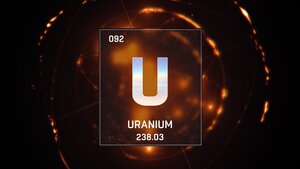We get the sense that some uranium investors are tired, distraught, and disappointed in the performance of the equities in the shadow of excellent and improving investment conditions occurring specifically in the uranium sector. Take some time and look at the equity trends in this market since 2016. Do we really have to repeat ourselves about slaughtering corrections this sector sees in an overall uptrend? If the uranium uptrend is over, then it will go down as a supply results "non-event" with the lack of supply response that has come out of it so far. The response this far is really next to nil or a rounding error that isn't impactful to the problem at hand. Just take a glance at primary production over the last two years versus expectations this year.
That delivers the point.
The term price of uranium was last reported by "official" sources at $72 per pound. Term pricing, while it has notable flaws in how it is reported, is still the super majority market clearing mechanism that the big money does its deals on. $72 per pound on paper today isn't representative of what is happening, including many conversations in the $80-90 per pound range that are occurring in confidence. $72 per pound also isn't considered "in-the-money" on a global project incentive price basis, inflation and escalation adjusted due to the clown show that occurred from 2020-2022.
Informed and well-studied market participants know that it is only a matter of time and disclosure, then truth told via financial results, that the term contracting price starts to creep higher. There is always a lag in this process.
Meanwhile, to see the spot price correct from a notable move higher to about $106 per pound on light volumes is much welcomed. Participants who think this market is a straight shot higher and is a quick financial result for them are just naïve and unprepared.
How many times since late 2016 have we seen sector equities get gut-checked?
Irrespective of the short to midterm jitters plaguing the equity traders and short-timers in uranium, the fundamental backdrop remains lucrative.
While there is some newfound sense of urgency, there is nothing new here. Folks should be prepared to see $80 per pound of uranium in the coming months, but if we get $120 per pound, we're satisfied either way, but there are arguments why this can go either way. Why would we be satisfied?
Because we actually understand the market, and that understanding settles us down. We don't care about equity moves on a weekly basis. Green or red generally shouldn't concern you on a daily basis. It should be due credited that the broad market continues to spread fear, and other sectors, such as technology, grab attention away from complex (at least for a generalist) and little-known sectors like uranium.
General lack of interest and poor sentiment natural resource sector wide also plays a role here. Broad market washout events continue to be likely, and we know uranium equities get slaughtered irrespective of the actual fundamentals. Positioning for this is a matter of cash, and we say never be without it or a means to get it.
As we like to say, on the first day on Uranium Street, give it time. For the new investor in the uranium sector, you are paying tuition now toward a better learning experience, should you stay and finish the course. You unlikely won't learn another way. Investors also need to realize that some early participants who obtained uranium at less than $30-40 per pound for physical investment/trade purposes may look to move some of those pounds and lock in profits after all of these years.
This is not unreasonable and has been done throughout this cycle. Remember that a few hundred thousand pounds can move this spot market up and down a few dollars without breaking a sweat. The spot price drops, and the new uninitiated investors don't understand the trader motives, financial year ends, month-end painting, coupon clipping, and general "churn" that can occur in the spot market at various times. Nothing new to see here.
Irrespective of the short to midterm jitters plaguing the equity traders and short-timers in uranium, the fundamental backdrop remains lucrative. We just can't help you with timing, those specific experience areas you may or may not lack in, and we also can't shore up weak knees. Let's look at what progress has actually been made since the spot price passed $100 per pound and has hovered there, +/-$10, so far since.
The reality is that next to nothing has really been accomplished. We are in a "wait and see" period for much of this market. This "wait and see" consists of a number of components. Many producers and developers are caught in the fog of war with a mix of disbelief or even irritation. In the case of irritation, it is because now the market is starting to force them into taking risks that they otherwise prefer not to take or have been accustomed to the business of not actually operating but just being a story to tell with a printing press.
Now, we have to start producing results or start looking like fools. We are in between these outcomes, hence the "wait and see" cumulative. On the other end, some, not all, utilities are in a state of the same "wait and see" for different reasons, as they don't yet know what to make of this market.
Is this really sticking?
Cameco has demonstrated, although with challenges, that it can get close to expectations coming out of Cigar Lake and McArthur River as continued ramp-up spans this year.
Some take measures to protect their book while others wait for further confirmation that the price is really what it says on the screen. In the fuel cycle, specifically conversion and enrichment, it is also "wait and see" with respect to making new capital commitments and even dealing with western fuel cycle expansion as new relationships seed and old relationships are rekindled as a result of the Ukraine-Russia war.
As history has proven, Russia continues to confirm with steadfast resolve. From yet another angle, it is "wait and see" for new-build developers who need time to refresh their economics (not again), organize their construction plans, and watch the price settle for some time before wrapping up those bankable term contracts that will be needed on significant projects.
Whether conventional banking, large equity, partners, or otherwise, all parties like to take their time, test models, conduct due diligence, and scrutinize. To many investors, it seems like it takes forever. Some of that is intentional, some is process, and some is perversion. From yet another perspective, it is "wait and see" for some because they executed teaser term contracts at prices that make them look like fools today.
Why did they sign these contracts, you ask? Was it really because they knew their costs, or was it more of a concealed yet sinister way to prove to investors that they could get a piece of paper with a famous utility just to wave it around the room? Was it done because they never did the work on the market fundamentals, therefore their incompetence and lazy approach was "papered over" for another reason? Did they do it to obtain compensation tied to performance goals? Is it not looking out for shareholder interests when a CEO does not understand or know well the sector in which they proclaim to operate in and also proclaim to be an expert in?
We are being too kind. Back to the supply question, the time needed for some type of supply response is quite lengthy due to management inaction and incompetence, lack of preparedness, capital constraints, lack of progress at the term contract table, and the general flavor of "wait and see" thinking that is prevailing at this time.
Notwithstanding, there remain to be some very competent people, talents, and strategies that make up some of these businesses in the sector. It is important to remind and say again that the term price sits at $72 per pound, at least on a last-reported basis. That figure lags the actual discussion table occurring now.
Participants who've been in the sector for some time understand that the term contract market is ultimately where the action is, and it will move higher in the coming years. There should be no concern with that outcome. In general, price reporting takes the lowest bid offered, even if a transaction isn't completed, RFP rejected, or if another award is made to a more responsible offeror.
Term contracting procurement teams have a lot of flexibility and discretion, due to secrecy and confidentially, to disclose & guide what they want. Regardless, the facts come out eventually via financials and those results can lag for many years if the supplier is not in production yet or hasn't committed to those deliveries in the short term.
Term contracting is now being carried into this junior segment of the supply side, because the low-hanging productive capacity (tier 1 suppliers) has been mostly booked out. Cameco Corp. (CCO:TSX; CCJ:NYSE) and Kazatomprom (KAP: LSE), both of which have little mid-term book available for new contracted pounds, have their own set of problems that have already been demonstrated.
With the contract books where they are, end-of-the-decade or later new build projects are the sources of additional uranium price exposure and growth for them.
Cameco has demonstrated, although with challenges, that it can get close to expectations coming out of Cigar Lake and McArthur River as continued ramp-up spans this year. These tier-one projects, however, are getting long in their life, and substantial capital expenditure will be needed to attempt to extend their respective mine life and to maintain the expected production profile in the late decade.
Telling or not, all of the best about any mine operation is placed at the front end of the mine life. There are too many reasons not to do so; think about it. With the Westinghouse merger, it is clear that Cameco is also focused on fuel cycle services, meaning that they have other areas of the market to focus on, too.
Uranium One Inc. and Orano are not in good shape, whether it be jurisdictional setbacks (more than one) or being short of pounds needed for services to others. With these factors, we reiterate that utilities have no choice but to bring their term contracting books to the junior sector and those elevated-risk counterparties.
Some will arrive with hat in hand and checkbook in hand, while others will be more prepared, but it's going to be entertaining. In concluding our thoughts for this brief update, Retail traders, investors, traitors, and cheerleaders alike are losing patience and composure as the market drags them through this muddy period.
Expect one or a mix of outcomes this year, another choppy digest period to which we are so accustomed to, and a sharp move higher on contracting demand, both with broad market impacts that can drive the sector higher or lower.
Recent weak hands that don't have a grip on the underlying sector data won't have the confidence to strengthen their positions, instead washing their hands of the sector stink. We stress that no solution has arrived just because the spot price for uranium has seen triple digits.
No meaningful supply response has occurred as a result of higher prices. A substantial amount of term contracting is still required and will be done in the coming years. No new build projects that are meaningful have been commissioned. Very few restart projects have been successful, and the jury remains out on the success of many of them.
Conditions are worsening within the fuel cycle supply chain. The air gap between spot and term markets may persist for a while as the final tiers of the supply side are incapable or unwilling to respond to RFPs. Most of them remain "production hopefuls" who have a lot of work to do.
Uranium fuel continues to be consumed amongst the global reactor fleet while the commissioning of newly built reactors is improving both in time and quantity. The outlook is exceptional, and we constantly look for valid reasons why this doesn't work. With that understanding, we urge caution as key global markets and economies are showing signs of stress, and there is always the case to factor that into your thinking when approaching allocation to the uranium sector. These liquidity events can crush these small equities, and you must have capital discipline to handle these events properly. Whether you are exposed, disposed, or on the fence, the next stages of the cycle continue.
| Want to be the first to know about interesting Uranium investment ideas? Sign up to receive the FREE Streetwise Reports' newsletter. | Subscribe |
Important Disclosures:
- As of the date of this article, officers and/or employees of Streetwise Reports LLC (including members of their household) own securities of Cameco Corp.
- Andrew Weekly: I, or members of my immediate household or family, own securities of: Cameco Corp. I determined which companies would be included in this article based on my research and understanding of the sector.
- Statements and opinions expressed are the opinions of the author and not of Streetwise Reports, Street Smart, or their officers. The author is wholly responsible for the accuracy of the statements. Streetwise Reports was not paid by the author to publish or syndicate this article. Streetwise Reports requires contributing authors to disclose any shareholdings in, or economic relationships with, companies that they write about. Any disclosures from the author can be found below. Streetwise Reports relies upon the authors to accurately provide this information and Streetwise Reports has no means of verifying its accuracy.
- This article does not constitute investment advice and is not a solicitation for any investment. Streetwise Reports does not render general or specific investment advice and the information on Streetwise Reports should not be considered a recommendation to buy or sell any security. Each reader is encouraged to consult with his or her personal financial adviser and perform their own comprehensive investment research. By opening this page, each reader accepts and agrees to Streetwise Reports' terms of use and full legal disclaimer. Streetwise Reports does not endorse or recommend the business, products, services or securities of any company.
For additional disclosures, please click here.
SmithWeekly Research Disclosures
SmithWeekly Research IS NOT a financial advisor, tax professional, broker, or legal advisor. SmithWeekly Research is a publisher of financial opinions and educational content. All information, data, strategies, reports, articles and all other features of our products are provided for informational and educational purposes only and should not be considered or inferred as personalized investment advice and is not intended to be, nor shall constitute, an offer to sell or solicit any offer to buy any security. We are researchers that provide opinion and commentary. We are not licensed professionals. You must enlist the services of properly licensed accountants, legal counsel, brokers, agents, and all other required professional services needed to help you make your decisions for your own situation. You should never act solely upon single party opinion or commentary. Certain US regulations prohibit us from giving personalized investment advice or other advice whatsoever on a personal basis. SmithWeekly Research does not accept any form of compensation whatsoever from companies or assets that we may research and write about. SmithWeekly Research does not recommend or endorse any brokers, dealers, or investment advisors. SmithWeekly Research's reports, writings and other media releases are based on its opinions, current news & events, interviews, corporate news & reports, SEC, SEDAR, other regulatory filings, and any other information learned from sources and experiences. Research may contain errors, and you should not make any financial decision based solely on what you read in SmithWeekly Research’s reports and writings. It’s your money, it’s your responsibility to perform your own due diligence, and you must make your own decisions. Be advised and aware that buying and selling financial instruments involves risk. We accept no liability whatsoever for any direct or consequential loss arising from any use of our writings, products, services, website, or other content. You are responsible for your own investment research and decisions. You should seek the advice of a qualified investment advisor and fully understand any and all risks before investing. Historical results of our products are no guarantee of future results. We make no representation that you will or are likely to experience similar results. All results of our recommendations are not based on actual buying and selling of securities. All results are based upon a hypothetical model portfolio. Hypothetical model portfolio results have limitations and do not reflect all components of actually buying and selling securities. Your actual results may vary based upon many factors. All content and references to third-party sources are provided solely for convenience. This information may be inaccurate, use at your own risk.


































